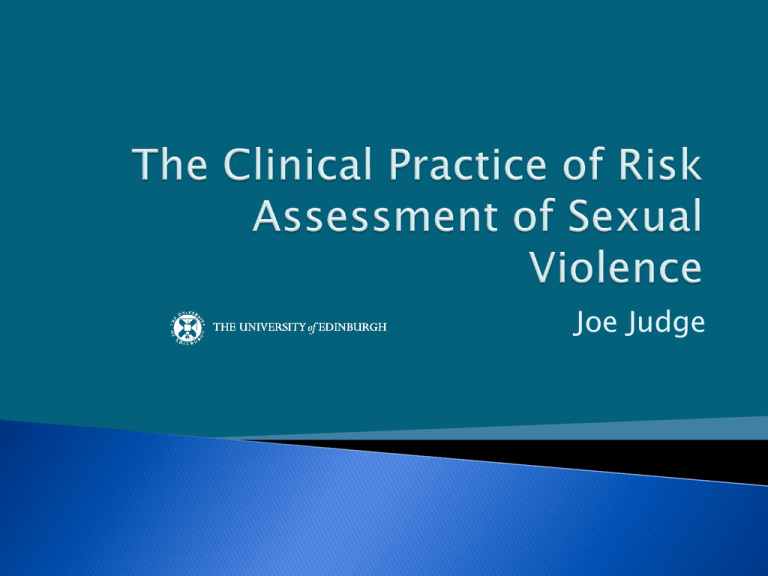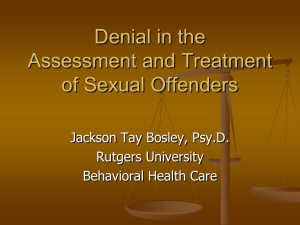
Joe Judge
There are significant literatures on risk
factors for recidivism in sexual offenders and
on the predictive accuracy of different types
of risk assessment tool.
Less is known about how risk factors are used
and combined in clinical practice.
This is especially true of Structured
Professional Judgement approaches.
Hanson and Bussiere (1998)
◦ Recidivism best predicted by sexual deviancy and
general criminological factors.
Hanson and Morton-Bourgon (2004, 2005)
◦ Uses cumulative meta-analytic technique
◦ Recidivism predicted by sexual deviance and
antisocial orientation.
Mann et al. (2010)
◦ Conceptualises risk factors differently
◦ “Psychologically meaningful risk factors”
Empirically Supported
Sexual preoccupation
Sexual preference for pubescent
or prepubescent children
Sexualised violence
Multiple paraphilias
Offence supportive attitudes
Emotional congruence with
children
Lack of emotionally intimate
relationships with adults
Lifestyle impulsiveness
Poor problem solving
Resistance to rules and
supervision
Grievance / hostility
Negative social influence
Promising
Hostile beliefs about women
Machiavellianism
Lack of concern for others
Dysfunctional coping
Sexualised coping
Externalised coping
Unsupported but with
interesting exceptions
Denial
Low self esteem
Major mental illness
Loneliness
Adversarial sexual orientation
Fragile narcissism
Sexual entitlement
Little or no relationship to
sexual recidivism
Depression
Social skills deficits
Poor victim empathy
Lack of motivation for treatment (as
assessed pre-treatment)
Sexual deviance is an evidence based risk
factor
Psychopathy is an evidence based risk factor
Inconsistent findings with respect to denial.
Also some gaps in the literature.
Looked at data from NHS Lothian Sex
Offender Liaison Service (SOLS)
Regression analysis of summary risk
judgements.
Are the factors that predict risk judgement
the factors that predict recidivism?
Or is something else important?
Developed to provide clinical input to help criminal justice
agencies manage sex offenders in the community.
Offers comprehensive clinical assessment of individuals
whom CJ agencies are finding difficult to manage.
78% have personality disorder diagnoses (Russell & Darjee,
2012)
Assessment and management advice structured using Risk
for Sexual Violence Protocol (RSVP)
Assessment process described in detail elsewhere (Russell
& Darjee, 2012)
Responses of 96 individuals used in data analysis
1.
2.
3.
4.
5.
Psychopathy will be a statistically significant
predictor of sexual violence risk score.
Sexual deviance will be a statistically
significant predictor of sexual violence risk
score.
Denial will not be a statistically significant
predictor of sexual violence risk score.
Sexual preoccupation will be a statistically
significant predictor of sexual violence risk
score.
Problems with intimate relationships will be a
statistically significant predictor of sexual
violence risk score.
Ordinal logistic regression
Dependent variables
Independent Variables
◦ MAPPA Risk Score
◦ RMA Risk Score
◦
◦
◦
◦
◦
Psychopathy (RSVP Item 12 – Coded 0-2)
Sexual Deviance (RSVP Item 11 – Coded 0-2)
Denial (RSVP Item 6 – Coded 0-2)
Sexual Preoccupation (SARN-SO – Coded 0-2)
Problems with intimate relationships (RSVP Item 16 –
Coded 0-2)
Psychopathy significantly associated with risk
score.
Sexual deviance was not significantly
associated with risk score.
Denial significantly associated with risk score.
Sexual preoccupation was associated with risk
score.
Problems with intimate relationships was not
associated with risk score.
Best model accounted for only 40 percent of
variance in risk score.
Explained by difficulty in assessing and
measuring sexual deviance?
Notoriously difficult task.
Do different types of sexual deviance operate
differently? (eg. Sexual sadism vs. paedophilia)
Outcome variables take into account
imminence of risk
For example, possible that offender may meet
criteria for paedophilia but have no access to
children – influences score on outcome
variable.
Relationship between denial is complex
Harkins et al. (2010) – Denial protective?
Depends on whether denial viewed
dichotomously or dimensionally.
Ware and Mann (2012) suggest overemphasis
on challenging denial.
Blagden et al (2011) suggest professionals not
always aware that they are challenging denial.
Is this operating in present study?
But again, denial difficult to assess and
measure
Closer scrutiny of the data revealed that only
5 percent of the offenders demonstrated no
evidence of problems with intimate
relationships
Unclear if this is true of sex offenders in
general or limited to those referred to the
SOLS.
Best explanatory model accounted for only 40
percent of variance.
Possible that relevant independent variables
not included in the analysis.
But what accounts for the other 60 percent?
The process of getting from item scores to
formulation, risk scenarios is not well
described.
Direction for future research?
Research investigating the process of SPJ risk
assessment.
How are risk judgements arrived at using this
method?
Hart and Boer (2010) suggest qualitative
analysis might be helpful.
Specific focus on risk formulation? (Reliability,
validity etc)
Difficulty in measurement of relevant
variables.
Revision of RSVP?
Debate about inclusion of denial as a risk
factor.










